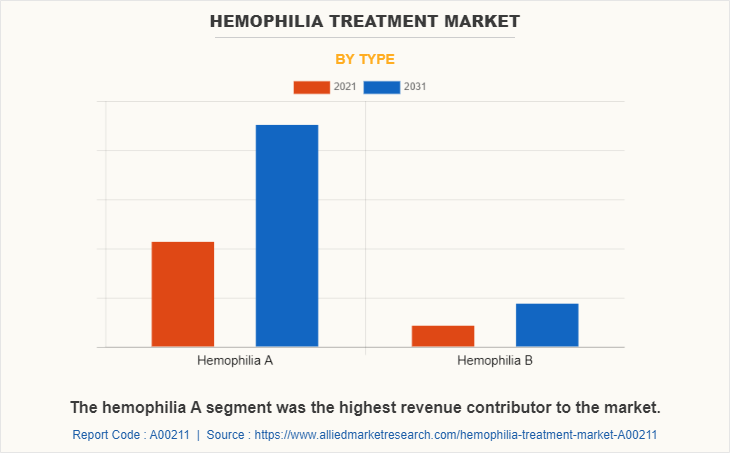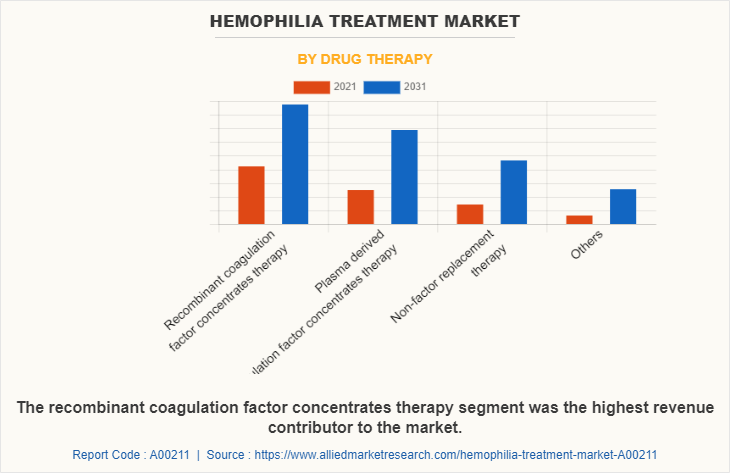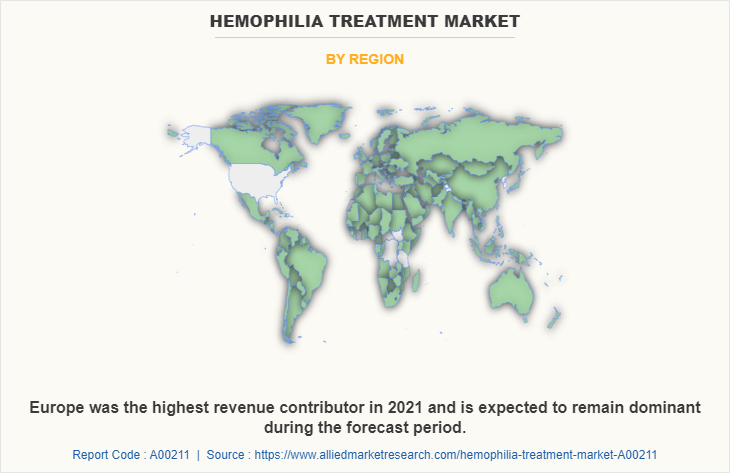Hemophilia Treatment Market Research, 2031
The global hemophilia treatment market size was valued at $12.8 billion in 2021, and is projected to reach $26.9 billion by 2031, growing at a CAGR of 7.5% from 2022 to 2031. Hemophilia refers to a group of bleeding disorders, in which blood clotting takes a long time. It is categorized mainly in two forms, namely hemophilia A and hemophilia B. It is caused by the lack of clotting factor VIII or IX in the blood. In most cases, hemophilia is passed down through families (inherited). It is passed mostly to the male children. The main symptom of hemophilia is bleeding. Mild cases are expected to remain undetected until recognized after excessive bleeding following surgery or an injury. In severe cases, bleeding occurs for no reason. Internal bleeding may occur anywhere and bleeding into joints is common. It is diagnosed after a person has an abnormal bleeding episode. It can also be diagnosed by a blood test to detect the problem, if other family members have the condition. The primary treatment is to replace the missing clotting factor in the blood through a vein (intravenous infusions). Special care needs to be taken during surgery if you have this bleeding disorder. So, the surgeon operating the patient must be informed about having this disorder. It is also very important to share information about the disorder with blood relatives as they may also get affected with the disease.
The growth of the hemophilia treatment market share is driven by increase in the prevalence of hemophilia, technological advancements in the treatment of hemophilia, and favorable government initiatives for hemophilia management.

The rise in R&D studies regarding treatment therapies in the segment, increase in target population, increase in diagnosis rate, and rise in the use of prophylactic treatment for hemophilia also contribute toward the hemophilia treatment market growth. However, high cost of hemophilia treatment, lack of medicines of hemophilia, and serious adverse effects associated with plasma derived products are expected to restrict the market growth. Conversely, the rise in the awareness about hemophilia in developing countries provides the hemophilia treatment market opportunity in the growth of the market.
Hemophilia Treatment Market Segmentation
The hemophilia treatment market is segmented into Type and Drug Therapy and Region. According to type, the market is divided into hemophilia A and hemophilia B. On the basis of drug therapy, the market is bifurcated into recombinant coagulation factor concentrates therapy, plasma derived coagulation factor concentrates therapy, non-factor replacement therapy, and others. Region-wise, it is analyzed across North America (U.S., Canada, and Mexico), Europe (Germany, France, UK, Italy, Spain and Rest of Europe), Asia-Pacific (Japan, China, Australia, India, South Korea, and Rest of Asia-Pacific), and LAMEA (Brazil, South Africa, Saudi Arabia, and Rest of LAMEA).
Hemophilia Treatment Market by Type Segment Review
By type, the hemophilia treatment market is categorized as hemophilia A and hemophilia B. The hemophilia A segment was the highest revenue contributor to the of hemophilia treatment industry during the forecast period, owing to the rise in incidence of hemophilia A and increased use of factor VIII. Hemophilia A is also projected to exhibit the fastest market growth rate of 7.6% during the forecast period, owing to technological advancements in treatment of hemophilia and product approval by the regulating authorities.

Hemophilia Treatment Market by Drug Therapy Segment Review
By drug therapy, the hemophilia treatment market is categorized as recombinant coagulation factor concentrates therapy, plasma derived coagulation factor concentrates therapy, non-factor replacement therapy, and others. The recombinant coagulation factor concentrates therapy segment was the highest revenue contributor to the hemophilia treatment market size during the forecast period owing to the increase in the number of recombinant technology products available for the treatment. Moreover, the non-factor replacement therapy segment is projected to exhibit the fastest market growth rate of 8.6% during the forecast period, owing to increase in target population and rise in research and development (R&D) activities on the treatment therapies.

Hemophilia Treatment Market by Region Segment Review
Europe was the highest revenue contributor in 2021 and is expected to remain dominant during the forecast period of hemophilia treatment industry. This was attributed to the research activities for hemophilia treatment, which are soaring in Europe, owing to the well-established healthcare facilities, recent technological advancements, and rise in demand for early diagnosis of hemophilia due to increase in awareness regarding the disease. Asia-Pacific is projected to register the highest CAGR of 8.3% during the forecast period, owing to increase in incidence of population suffering from hemophilia. In addition, increase in healthcare expenditure offers a lucrative opportunity for the market growth.

Competition Analysis
The major companies profiled in the report include Bayer AG, Pfizer, Inc., F. Hoffmann-La Roche AG, CSL Ltd., Takeda Pharmaceuticals Company Ltd., Novo Nordisk A/S, Grifols S.A., Swedish Orphan Biovitrium AB, Octapharma AG, and Medexus Pharmaceuticals Inc.
Key Benefits For Stakeholders
- This report provides a quantitative analysis of the market segments, current trends, estimations, and dynamics of the hemophilia treatment market analysis from 2021 to 2031 to identify the prevailing hemophilia treatment market opportunities.
- The market research is offered along with information related to key drivers, restraints, and opportunities.
- Porter's five forces analysis highlights the potency of buyers and suppliers to enable stakeholders make profit-oriented business decisions and strengthen their supplier-buyer network.
- In-depth analysis of the hemophilia treatment market segmentation assists to determine the prevailing market opportunities.
- Major countries in each region are mapped according to their revenue contribution to the global market.
- Market player positioning facilitates benchmarking and provides a clear understanding of the present position of the market players.
- The report includes the analysis of the regional as well as global hemophilia treatment market trends, key players, market segments, application areas, and market growth strategies.
Hemophilia Treatment Market Report Highlights
| Aspects | Details |
| By Type |
|
| By Drug Therapy |
|
| By Region |
|
| Key Market Players | Novo Nordisk A/S, Takeda Pharmaceuticals Company ltd, octapharma ag, CSL Ltd. (CSL Behring), Grifols, S.A, Swedish Orphan Biovitrum AB, Pfizer Inc., F. Hoffmann-La Roche AG, Bayer AG, Medexus Pharmaceuticals Inc. |
Analyst Review
Hemophilia is an inherited bleeding disorder that occurs when blood clotting factors are faulty or missing, in which the bleeding can happen both, internally and externally. Significant technological advancements in hemophilia treatment products lead to the provision of advanced treatment options for the management of hemophilia in population. The demand for new hemophilia treatment options is on a continuous rise, due to surge in target population and increase in number of diagnostic procedures globally. As the market is saturated and growing at a steady rate in developed nations, the Asia-Pacific and LAMEA regions are expected to offer ample growth opportunities to key players in the market.
Moreover, emerging markets gain importance for majority of the hemophilia treatment products manufacturers and distributors, as they focus towards unmet demand for treating the disease in these regions. Hence, many companies have started introducing technologically advanced products to cater the needs of rising population, especially in developing economies. Rapid growth was observed in the shipments of these products to provide improved healthcare services in emerging nations, and this is expected to offset the challenging conditions in mature markets, such as North America and Europe. Europe is expected to dominate the global hemophilia treatment market size during the forecast period, followed by North America.
The total market value of hemophilia treatment market is $26,905.2 million in 2031.
Increase in the prevalence of hemophilia, technological advancements in the treatment of hemophilia, and favorable government initiatives for hemophilia management are the key trends in the hemophilia treatment market report.
Top companies such as Bayer AG, Pfizer, Inc., F. Hoffmann-La Roche AG, CSL Ltd., Takeda Pharmaceuticals Company Ltd., and Novo Nordisk A/S held a high market position in 2021. These key players held a high market postion owing to the strong geographical foothold in different regions.
Asia pacific is expected to exhibit the fastest growth rate of CAGR 8.3% due to the increase in incidence of population suffering from hemophilia.
Yes, the hemophilia treatment market provides PORTER Analysis in the report.
Loading Table Of Content...


